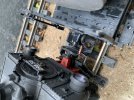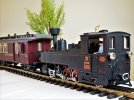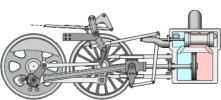AustrianNG
Director of my railway
Those of you that possess a U Class loco or two may have tried to run the loco cab first.
then as soon as the gradient changes, the wagon/ coach behind the loco uncouples
there are two reasons for this:
1. The loop on the loco is a little higher than most stock loops and hooks
2. It is not possible to mount a hook on the front loop unless you are prepared to carry out major surgery on the chassis.
The solution I have implemented on my railway is a simple length of single core copper wire bent into a “U” shape (no pun intended). The wire is about 24mm long and bent into 3 8mm segments and simply hooked over both loops and gently wedged under the central buffer.

then as soon as the gradient changes, the wagon/ coach behind the loco uncouples
there are two reasons for this:
1. The loop on the loco is a little higher than most stock loops and hooks
2. It is not possible to mount a hook on the front loop unless you are prepared to carry out major surgery on the chassis.
The solution I have implemented on my railway is a simple length of single core copper wire bent into a “U” shape (no pun intended). The wire is about 24mm long and bent into 3 8mm segments and simply hooked over both loops and gently wedged under the central buffer.







